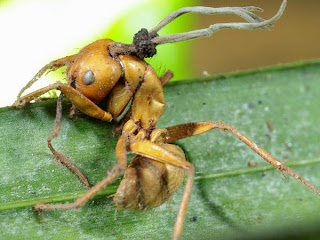
1 - Area 51 Spy Plane, Intact - here
Suspended upside down, a titanium A-12 spy-plane prototype is prepped for radar testing at Area 51 in the late 1950s.
After a rash of declassifications, details of Cold War workings at the Nevada base, which to this day does not officially exist, are coming to light—including never before released images of an A-12 crash and its cover-up, National Geographic News reported in May.
Photograph from Roadrunners Internationale via Pangloss Films
After a rash of declassifications, details of Cold War workings at the Nevada base, which to this day does not officially exist, are coming to light—including never before released images of an A-12 crash and its cover-up, National Geographic News reported in May.
Photograph from Roadrunners Internationale via Pangloss Films

2 - Rare "Cyclops" Shark Found - here
An extremely rare cyclops shark has been confirmed in Mexico, scientists announced in October.
Photograph courtesy Marcela Bejarano-Álvarez

3 - Yellowstone's Supervolcano Bulged - here
Yellowstone National Park's supervolcano recently took a deep "breath," causing miles of ground to rise dramatically, scientists reported in January.
Photograph by Mark Thiessen, National Geographic
4. Biggest Crocodile Caught? - here
Caught alive after a three-week hunt, a roughly 21-foot-long (6.4-meter-long) saltwater crocodile caught in the Philippines may be the largest crocodile yet captured, officials said in September.
Photograph from Reuters
5. New Fungi Make "Zombie" Ants - here
A stalk of the newfound fungus species Ophiocordyceps camponoti-balzani grows out of a "zombie" ant's head in a Brazilian rain forest.
Originally thought to be a single species, called Ophiocordyceps unilateralis, the fungus is actually four distinct species—all of which can "mind control" ants—scientists announced in March.
Photograph courtesy David Hughes

6. Biggest Great White Shark Caught - here
Talk about a big fish: An expedition crew hauled up—and released—the biggestgreat white shark yet caught, a team said in May.
The 17.9-foot-long (5.5-meter-long) male behemoth was found off Mexico's Guadalupe Island in fall 2009.
A possible Earth twin was confirmed orbiting a sunlike star 600 light-years away. Discovered by the Kepler space mission, the new planet—dubbed Kepler-22b—is the first world smaller than Neptune mission scientists have found in the middle of its star's habitable zone.
8. Lost Maya City Revealed - here
Archaeologist Brigitte Kovacevich crouches near a looters' tunnel inside the pyramid at the Head of Stone, an ancient Maya city that's finally coming into focus.Using GPS and electronic distance-measurement technology, the researchers plotted the locations and elevations of a seven-story-tall pyramid, an astronomical observatory, a ritual ball court, several stone residences, and other structures. Photograph courtesy Michael G. Callaghan

9 - Blackbeard's Sword? - here
Photograph courtesy Wendy M. Welsh, North Carolina Department of Cultural Resources
Could this partly gilded hilt have held Blackbeard's sword? There's no way to know for sure, though it was found amid the North Carolina wreck of the Queen Anne's Revenge, the flagship of the infamous 18th-century pirate.
Photograph courtesy Wendy M. Welsh, North Carolina Department of Cultural Resources
10. Possible Earthlike Planet Spotted - here
Illustration courtesy L. Calçada, ESOA new planet found about 36 light-years away could be one of the most Earthlike worlds yet—if it has enough clouds. The rocky planet's discovery became the tenth most visited National Geographic News story of 2011.
Illustration courtesy L. Calçada, ESO




Sem comentários:
Enviar um comentário